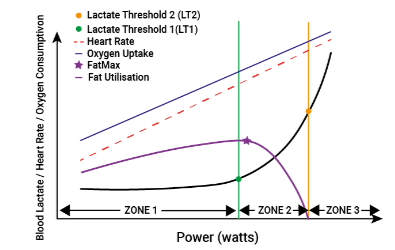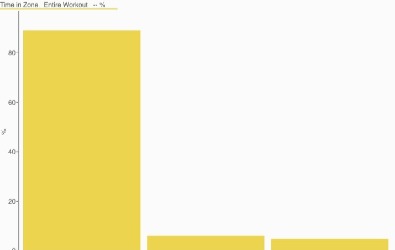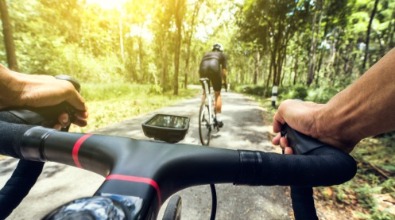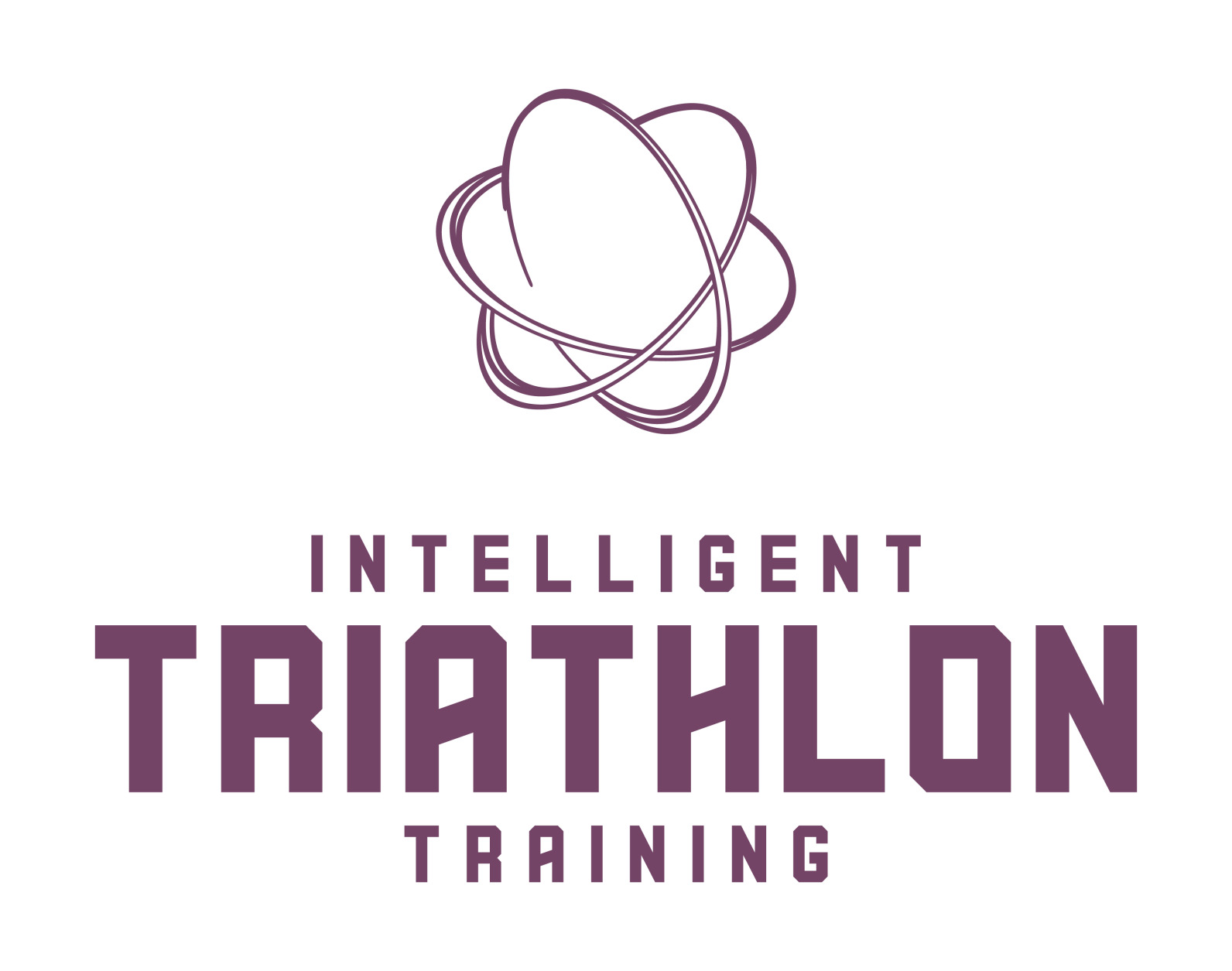Understand Bike Training Sessions TYPES
Here we explain the training session terminology and relating it to the training zones we use for analysis.
First though, lest visit training zones as this can cause a lot of confusion.
3 Zone Model
The 3 zone model of training intensity breaks intensity down by physiology.
Zone 1 = intensity below Lactate Threshold 1 (LT1). At this intensity, the metabolism is predominantly aerobic with very little carbohydrate required.
Zone 2 = intensity above LT1 but below Lactate Threshold 2 (LT2). Whilst not strictly true in science for the purposes of coaching we use Functional Threshold Power instead of LT2.
Zone 3 = intensity above FTP.

A representation of how the 3 zone model relates to physiology.

An example of the power distribution in the 3 zones in an Extensive Endurance Ride.
Alternative Models
There are A LOT of training zone models, but what they all fundamentally do is break the 3 zones down into more manageable ranges. For instance just over FTP is a duration that an athlete can sustain for 20 - 30min, whereas a maximal sprint can be sustained for a few seconds. That example ranges from 101% FTP to potnetially > 400% FTP.
Training Peaks allow a few different models to be automatically calculated, other software use different variations.
For training prescription, we tend to use % of FTP in the description for intensity, and use training zones for analysis of the session afterwards and for longer evaluation of the programme.
In that analysis we use WKO5 and with that, we use a 9 Zone System. This breaks the zones in the 3 zone model down as follows:
- Zone 1 into 2, with a Recovery and an Endurance zone.
- Zone 2 into 2 with a Tempo zone and a Sweetspot Zone
- The 5th zone bridges Zones 2 & 3 and is around FTP.
- Zone 3 into 4 with zones broken down from 105% FTP to maximal 1-sec power.
This breakdown helps us to understand where the effort has been applied and understand how the training was achieved.

Triathlon Bike Session Types
These are the main types of sessions we use when setting triathlon bike programmes
Recovery
Neuromuscular Recovery (NR) sessions use a low overall intensity and load and utilise a range of cadence. These create a neural stimulus but at a low physiological cost.
Recovery (R) sessions are more conventional low-intensity low-load rides.
Endurance
Extensive Endurance (EE) sessions are the conventional long steady distance sessions (LSD), these are moderate to high load and last multiple hours. Within triathlon training, we normally want to see these with a moderate variability index (VI) of 1.08 - 1.18. This is the ratio of average power to normalised power. In order to achieve this, the ride needs to be consistent, and large group rides on a regular basis are generally not the most efficient means of achieving the aims of this ride. If you have a very high-volume programme then there is more scope for group rides.

Intermediate Aerobic Endurance (IAE) sessions comprise of Sweetspot (88 - 95% FTP) which is usually performed as long intervals, and Tempo (76 - 88% FTP) which can be performed as one long rep up to 2hrs or for trainer sessions broken long reps with short recoveries. Both of these should have a low Variability Index of <1.08, ideally less than 1.04 within the reps.
Intensive Endurance (IE) sessions can be one long rep close to FTP or 2 -3 shorter reps with short recovery. These are very high load sessions and consequently are not performed too regularly in training. Time trials can often replace these sessions as the intensity for 10 or 25mile TTs work quite well.
High Intensity
These sessions can be performed outside on the road, but for the maximum benefit, the trainer is a better option to ensure the quality is in each rep and the power delivery is consistent and even. FRC sessions can be an exception to this as they are very short intervals at very high powers with long easy recoveries.
Functional Threshold Development (FTD) sessions are target longer reps just over FTP, how long the reps are should be set for each individual depending upon their Functional Reserve Capacity. The aim of the sessions is to accumulate 30 - 90min of time over FTP. How much and session design is dictated by the athlete's physiology and training experience as well as the requirements of the programme. A rider with a high FRC will be able to sustain an intensity above FTP for longer than a ride with a lower FRC.

Maximum Aerobic Power (MAP) sessions are higher intensity than FTD targetting the power at VO2max which is usually 112 - 118% FTP. Again the aim is to accumulate as much time as possible within 12 - 30min again depending upon the rider's physiology, experience, and requirements.
Functional Reserve Capacity (FRC) these sessions are very high intensity and require significant rest between efforts to maximise the training effect. In reality, we do not use these very often in triathlon training as developing FRC is not very often required due to the steady-state nature of most triathlon events
Torque based sessions - Overgear
In most of the above-mentioned sessions, the rider can choose their prefered cadence for the requirements of the sessions. High Torque sessions use over gear or lower cadence efforts to develop specific characteristics in the pedalling dynamics. Low cadence means more force has to be applied to the pedals to produce the same power. So at 200w for example, twice as much force needs to be applied to each pedal revolution at 50rpm as it does at 100rpm. These sessions can help to develop muscular endurance and improved pedalling action through great muscle fibre recruitment. One characteristic of these sessions is that heart rate is often much lower than expected for the same power, compared with a higher cadence.
Intermediate Torque Production (ITP) sessions utilise long repetitions (10 - 30min) of 82 - 90% FTP at a low cadence. To be effective everyone needs to be below 65rpm, but for athletes with a naturally low cadence or more competent/experienced athletes, we can go as low as 40rpm.
MAP Torque Development (MAPTD) sessions are performed close to VO2max power for 45 - 90sec repetitions with a 1:1 work to rest ratio. Cadence needs to be below 65rpm with the object being to produce the power with the lowest cadence you can. So if that is 65rpm today that's fine, however, if you can produce the target power with a lower cadence then you should do so.
Fatigue Resistance
These are very high load sessions designed to improve an athletes fatigue resistance. In other words to maintain a higher percentage of FTP for longer. Often athletes focus on building FTP, but they are not able to hold an optimal percentage of this for a race due to muscular fatigue. These sessions create a lot of fatigue and are not used frequently in a programme.
They can often be placed in the final phases before a major race, and are an ideal opportunity to practice race fuelling.
